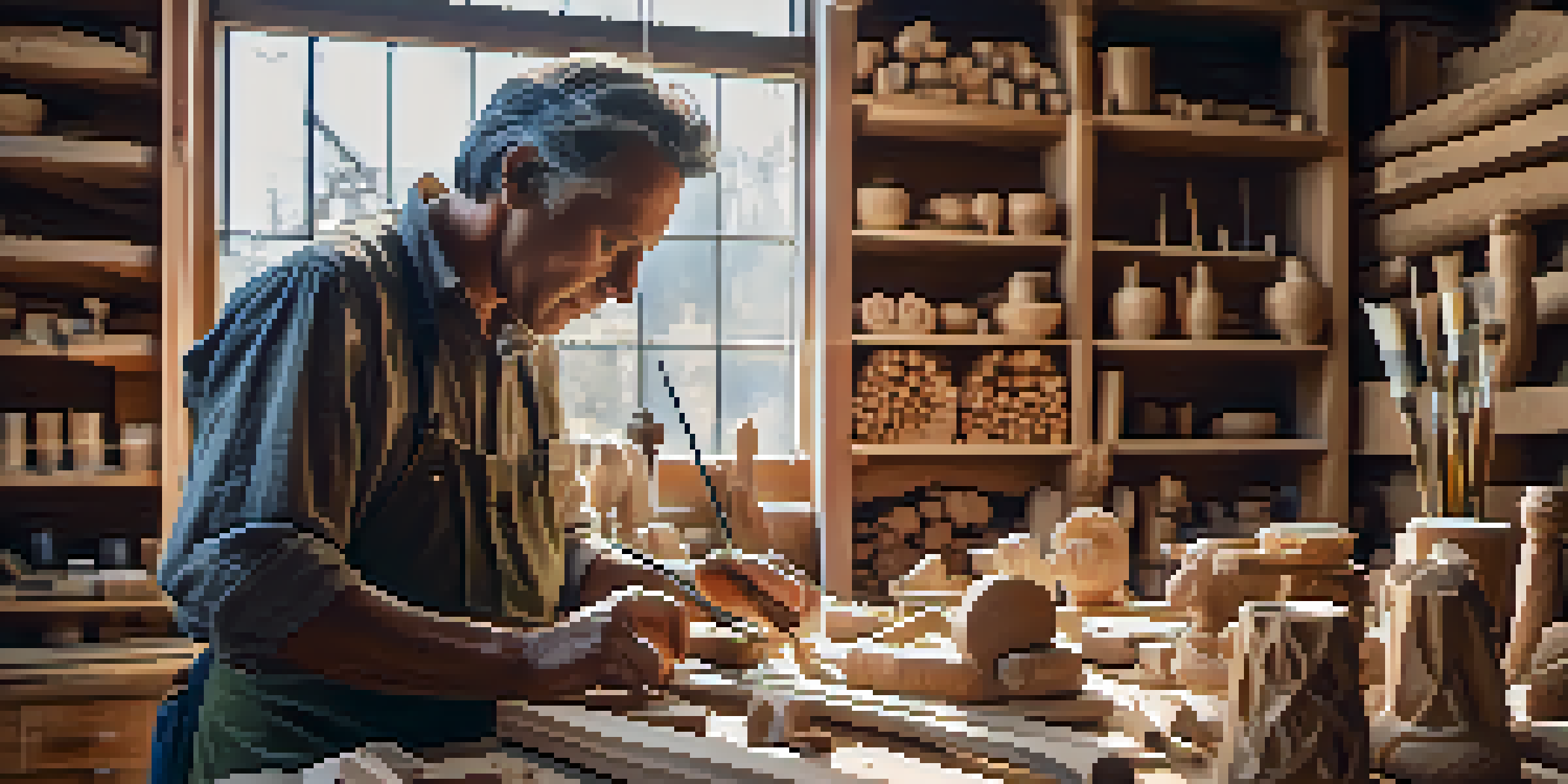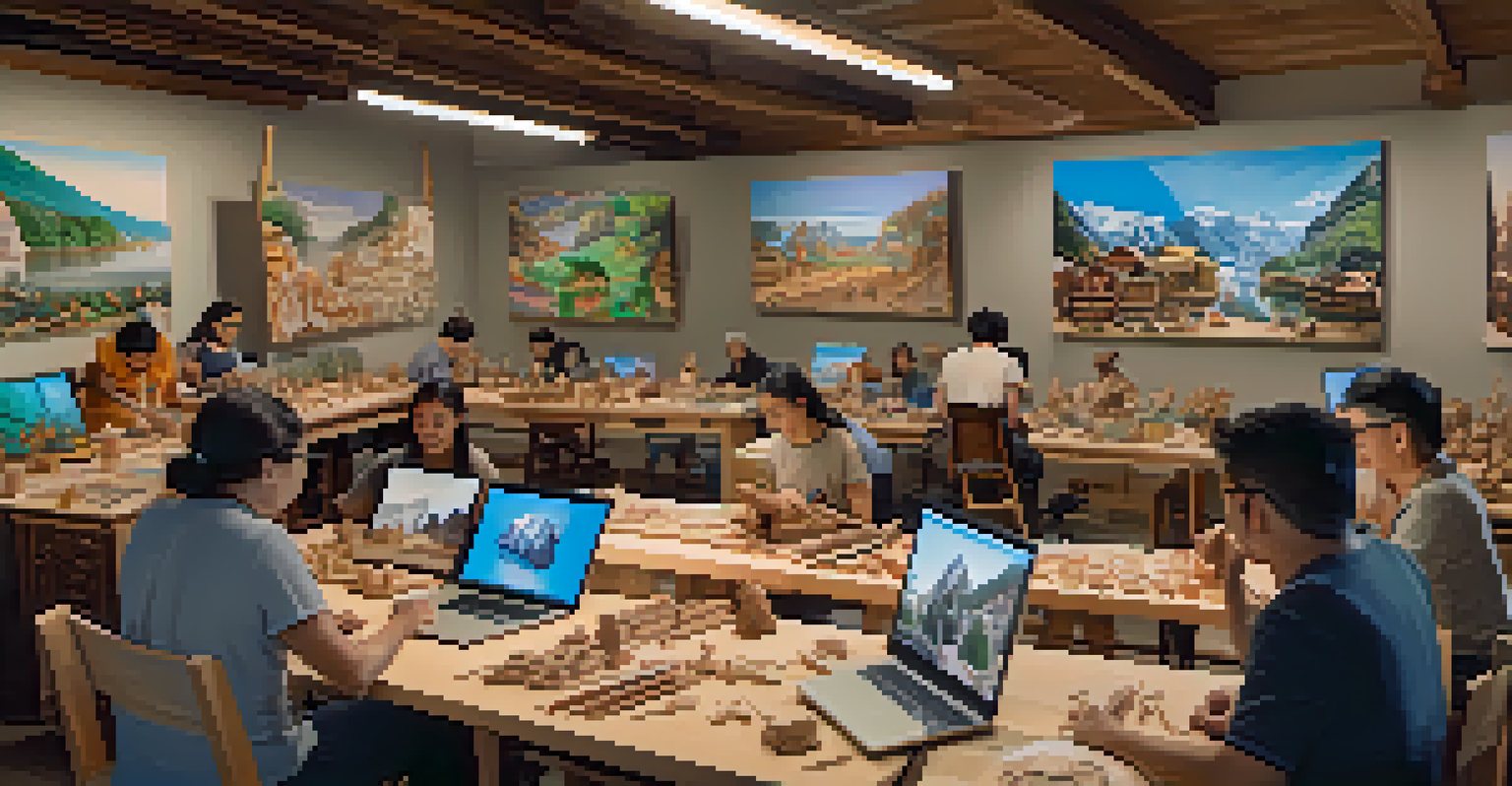The Impact of Modern Technology on Traditional Carving

Understanding Traditional Carving Techniques and Their Roots
Traditional carving is an ancient art form, deeply rooted in various cultures. It involves using hand tools to create intricate designs from wood, stone, or bone. Each piece tells a story, reflecting the craftsmanship of its creator and the traditions of a community.
Every piece of carving tells a story, reflecting the craftsmanship of its creator and the traditions of a community.
Carving has served practical purposes, from creating tools to decorative art. Historically, artisans passed down their skills through generations, preserving techniques that highlight their cultural heritage. This organic transmission of knowledge is vital in maintaining the integrity of traditional carving.
However, as society evolves, so does the context in which these traditional practices exist. The intersection of art and technology presents both challenges and opportunities, inviting us to reflect on how these old techniques can adapt in a modern world.
The Role of Modern Technology in Contemporary Carving
Modern technology has introduced tools like CNC machines and laser cutters, revolutionizing the carving process. These machines allow for precision and consistency that hand carving might not achieve, drastically reducing production time. For example, a skilled artisan might take weeks to finish a piece, while a CNC machine can replicate it in hours.

While some view this as a threat to the authenticity of traditional carving, others see it as a new medium for creativity. Artists can now combine their traditional skills with digital design, exploring new forms that were previously unimaginable. This blend of old and new fosters innovation in the carving community.
Tradition Meets Modern Technology
Traditional carving techniques are evolving through the integration of modern tools, allowing artisans to blend heritage with innovation.
Moreover, technology provides a platform for artists to showcase their work to a global audience. Social media and online galleries have enabled artisans to reach potential buyers far beyond their local markets, ensuring that their craft remains relevant in today’s economy.
Preservation of Traditional Techniques Through Technology
Ironically, modern technology can play a crucial role in preserving traditional carving techniques. Digital documentation, such as high-resolution photography and video tutorials, allows techniques to be recorded and shared widely. This ensures that knowledge is not lost, even as the tools of the trade evolve.
Art is never finished, only abandoned.
Virtual workshops and online courses enable artisans to learn from masters around the world, fostering a global community of carvers. This interconnectedness creates opportunities for collaboration and the exchange of ideas, enriching the traditional craft. For instance, a carver in one country can learn a technique from a master in another, blending styles and methods.
Additionally, tech-driven preservation efforts can help protect endangered carving traditions. By raising awareness and generating interest, technology encourages younger generations to engage with their cultural heritage, ensuring that traditional carving continues to thrive.
Balancing Tradition and Innovation in Carving
Finding a balance between traditional methods and modern innovations is essential for the future of carving. While technology offers exciting possibilities, it’s crucial to maintain the essence of the craft. Artists face the challenge of integrating new tools without losing the personal touch and storytelling aspects of their work.
Many artisans are choosing to combine both worlds, using technology for preliminary designs while finishing their pieces by hand. This hybrid approach allows them to benefit from efficiency while preserving the unique qualities that define traditional carving. For example, an artist might use a laser cutter for initial shapes, then add intricate details using hand tools.
Social Media Transforms Carving
Social media platforms are fostering a global community among carvers, enhancing visibility and collaboration while attracting new enthusiasts.
By embracing both tradition and innovation, carvers can create pieces that resonate with contemporary audiences while honoring their roots. This synthesis not only keeps the craft alive but also encourages a dialogue between generations.
The Impact of Social Media on Carving Communities
Social media has dramatically transformed how carving communities connect and share their work. Platforms like Instagram and Pinterest allow artists to showcase their creations to a vast audience, gaining feedback and inspiration. This visibility can lead to new opportunities, collaborations, and even sales, making carving more accessible and relevant.
Moreover, social media fosters a sense of community among carvers, allowing them to share techniques, tips, and resources. Online groups and forums provide spaces for discussion, where both seasoned artisans and novices can ask questions and learn from one another. This camaraderie helps keep the passion for carving alive across different demographics and locations.
Through social media, traditional carving can reach new enthusiasts who may not have had exposure to the craft. This is essential for the survival of the art form, as it encourages the next generation to explore and engage with carving, ensuring its continued evolution.
Challenges Faced by Traditional Carvers Today
Despite the benefits of modern technology, traditional carvers face several challenges in today’s fast-paced world. One significant issue is the commodification of art, where unique pieces are sometimes undervalued compared to mass-produced items. This can make it difficult for artisans to sustain a living solely through their craft.
Additionally, the rapid pace of technological advancement can be overwhelming for some traditional carvers. While many embrace new tools, others may feel pressured to conform to industry trends, risking the loss of their unique artistic voice. This tension highlights the importance of staying true to one's craft while finding ways to adapt.
Challenges for Traditional Carvers
Despite technological advancements, traditional carvers face challenges such as the commodification of art and the need to engage younger audiences.
Furthermore, as younger generations gravitate towards digital creations, there is a risk of traditional carving being overshadowed. Carvers must find ways to engage with contemporary audiences, demonstrating the relevance and beauty of their craft in an increasingly digital world.
Future Directions for Traditional Carving in a Tech-Driven World
Looking ahead, the future of traditional carving lies in its ability to adapt and innovate. Artists are increasingly experimenting with new materials and techniques, blending traditional carving with digital art forms. This evolution can lead to the emergence of entirely new styles that honor the past while embracing the future.
Moreover, educational institutions and workshops are beginning to incorporate technology into their curricula, teaching aspiring carvers how to navigate both traditional and modern techniques. This holistic approach ensures that future artisans are equipped with a diverse skill set, allowing them to thrive in an ever-changing landscape.

Ultimately, the continued growth of carving will depend on the community's willingness to embrace change while cherishing its heritage. By fostering a dialogue between tradition and innovation, traditional carving can remain a vibrant and evolving art form for generations to come.